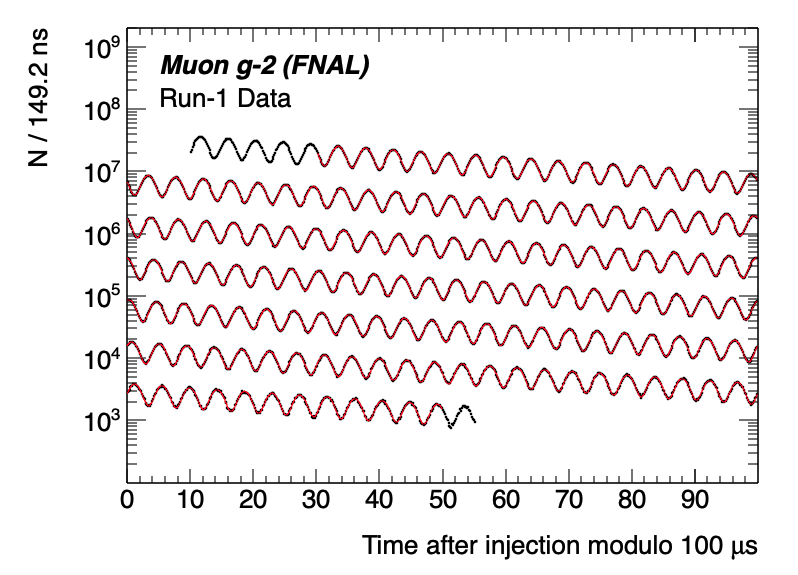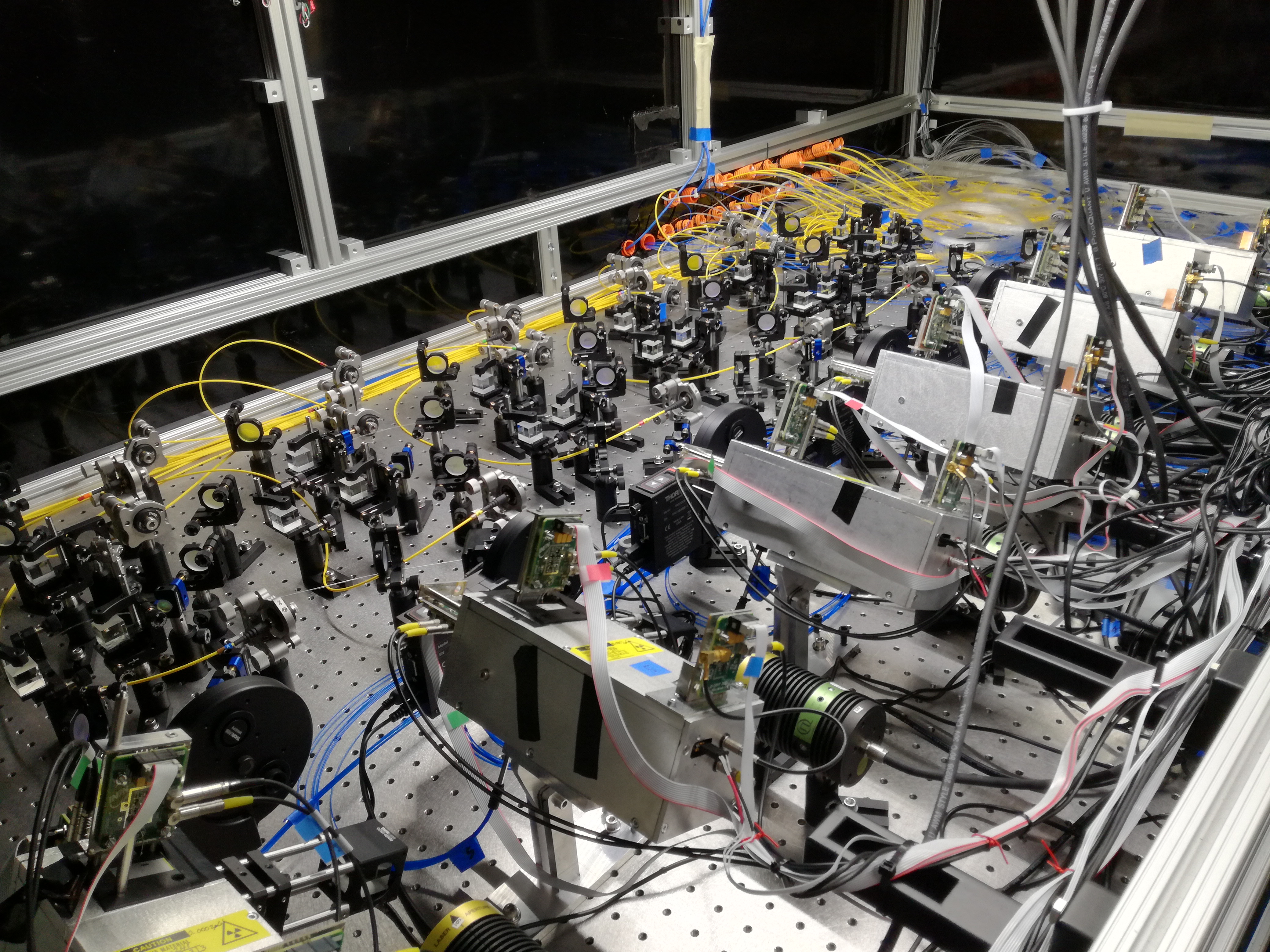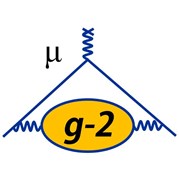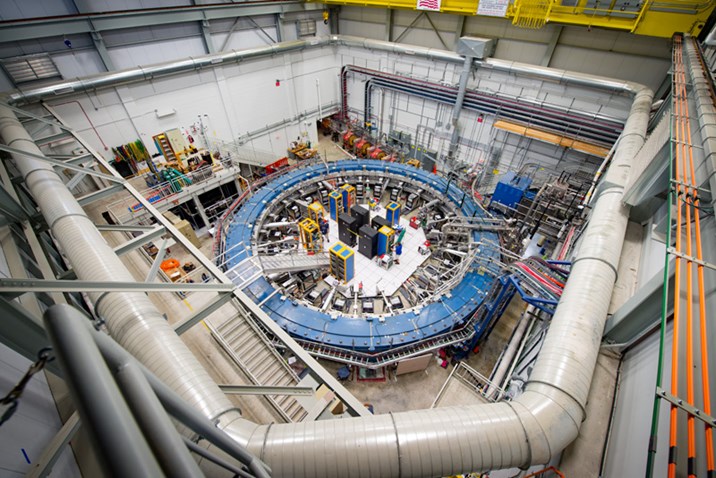Esperimento Muon g-2

Fermilab's Wilson Hall

The "Wiggle Plot": the key plot to extract the anomalous precession frequency of the muon. The time here is wrapped every 100µs in order to show the exponential decay. The wiggles are from the anomalous precession frequency modulation.

The Muon g-2 Laser Calibration System: is a state-of-the-art laser system developed by the INFN. The aim of this system is to provide a stable light source for the calibration of the 1296 SiPM in the calorimeters.
![The latest result for the muon anomaly. Note: the Standard Model value is the one published in the Theory White Paper [5], see text for details.](/media/vv2bbhrm/risultato.png)
The latest result for the muon anomaly. Note: the Standard Model value is the one published in the Theory White Paper [5], see text for details.
OVERVIEW

Muon g-2, located at Fermilab (Illinois - 60 km from Chicago), is a precision particle physics experiment built to measure the muon's anomalous magnetic moment with the precision of 0.14 parts per million (ppm).
The actual g-2 value is sensitive to all particles being created in the vacuum and interacting with the muon itself. It can be both measured and computed with high precision, so this measure is a very sensitive probe to New Physics, because any deviation would point to as yet undiscovered subatomic particles that exist in nature.
The experiment began its data taking in 2018 with the first physics run (results published on the 7th of April 2021). It is now (2021) collecting the run 4 data and is planned another run beginning next autumn.
RESEARCH GROUP AT THE UNIVERSITY AND INFN TOR VERGATA
Giuseppe di Sciascio, Matteo Sorbara, Silvia Miozzi, Giovanni Pasquino
THE PHYSICS MOTIVATION
From the Dirac’s equation the gyromagnetic factor of the muon (and in general for a fundamental Fermion) can be predicted to be 2. Higher order contributions from the virtual particles interacting with the muon increase this value by ~0.1%. The difference from 2 is the “Muon Anomaly” (hence the name Muon g-2) and it contains all the contributions coming from QED and Hadronic interactions.
QED contributions can be computed with a very high precision given the perturbative nature of the QED itself. The hadronic terms instead need a different approach: they are based on the experimental data from e+e- scattering and are connected to g-2 via a dispersion relation.
The interest in g-2 measure began in the 60s as an experimental verification of the QED. The first storage ring measurement has been developed by Combley, Farley and Picasso at CERN.
Between 1999 and 2001 the E821 experiment at Brookhaven National Laboratory reached the groundbreaking precision of 0.54 ppm in the measure, and this value showed a discrepancy (3-4 standard deviations) with the predicted value from the Standard Model.
This deviation can be a hint of unknown contribution to the g-2 value. The Muon g-2 experiment at Fermilab has been developed to improve the experimental precision by a factor four in order to clarify the origin of this difference.
THE EXPERIMENT
The principle of the experiment is to measure the anomalous precession frequency of the muon in a magnetic field. This frequency is the difference between the spin precession and the cyclotron frequencies, and it’s proportional to the magnetic field magnitude through a constant that contains the muon anomaly (g-2)/2. In particular, if the gyromagnetic factor is 2, the anomalous precession frequency should be zero.
The aim of the experiment is to measure how fast the muon spin precesses around the momentum direction. To do this we can take advantage of the parity violating µ+ decay: the high energy positrons are emitted preferentially in the muon’s spin direction; a detector along a fixed direction will count the number of positrons modulated by the spin precession frequency. So for the measure we just need to count the number of high energy positrons.
MUON g-2 AT FERMILAB

The main component of the Muon g-2 experiment is a 15 m diameter storage ring repurposed from the previous experiment at BNL. The magnet was shipped from the New York State to Fermilab via barge along the US east coast, around Florida and then, through the Mississippi river to Illinois. There, by truck, arrived at Fermilab after 1 month (and ~5000 km). The magnet has then been reassembled in its new home. During the assembly process has been carefully shimmed in order to make the magnetic field as uniform as possible.
A beam of polarized anti-muons at 3.1 GeV energy are produced from the Fermilab’s accelerators chain and injected into the storage ring. The decay positrons are detected by a system of 24 electromagnetic calorimeters placed along the inner circumference of the ring in order to precisely measure their energy and arrival time. Each calorimeter is made of 54 Lead Fluoride (PbF2) crystals. Large area Silicon Photomultipliers (SiPM) detect the Čerenkov light from the electromagnetic shower to measure the energy of the original positron.
The plot shown on the right is the so-called “wiggle plot” and it is the key to extract the anomalous precession frequency: it shows the number of high energy positrons (E>1.7 GeV) measured by the 24 calorimeters. In the plot is clearly visible the muon decay exponential (wrapped every 100 µs), and it is also possible to see the modulation given by the anomalous precession frequency. To extract this frequency a complex analysis has been developed in order to remove pile-up and to fit the data points shown in the wiggle plot. The fitting equation is a 22 parameters equation that takes into account the decay exponential, the cosine modulation term (containing the anomalous precession frequency) and all the beam dynamics corrections (horizontal and vertical oscillations, beam drift…).
THE GAIN MONITORING
Every time-dependent effect has to be taken into account when extracting the precession frequency. In particular SiPMs can be affected by gain changes (order 1 - 10 ns) due to the high rate of particles hitting the calorimeter and slow changes (order 1 day) due to temperature variations. In order to monitor and correct these changes, a state-of-the-art laser system has been developed and built by the INFN group.
The laser system sends a light pulse through optical fibers to each of the 1296 SiPMs in order to measure their response and to correct for any gain variation. The system itself is stable at a 10^-4 level during the data-taking, and brings the gain-related uncertainties below 10 ppb.
THE LATEST g-2 MEASURE
On the 7th of April 2021 the result from the first run of data have been published. The new value has been measured with a precision of 0.46 ppm and it confirms the previous measurement from BNL. The combined result shows a discrepancy with the Standard Model’s prediction* of 4.2 standard deviations, suggesting a stronger clue of new physics in the g-2 value. Next runs are crucial to further reduce the uncertainty on the experimental value.
THE FUTURE
The experiment is now collecting data for the run 4 campaign, and a run 5 is planned to reach the statistical goal of 21 times the BNL data. In the mean time the data from run 2 and 3 are under analysis. An improved beam storage will lead to smaller beam-related systematics, and in general the new data are expected to reduce the uncertainty by a factor 2.
*The Standard Model’s prediction here refers to the result published in the Theory White Paper [5], where the group of theorists reached a world consensus on the value, based on the computation of the hadronic contributions using the dispersion approach (with experimental data). A new approach using ab-initio Lattice QCD calculations has been recently published [6] and it has been showed to give results compatible with the experimental value. This result, if confirmed, may lead to a tension between the two different theory approaches that needs to be further investigated.
References:
- B. Abi et al. (Muon g-2 Collaboration) - Measurement of the Positive Muon Anomalous Magnetic Moment to 0.46 ppm - Phys. Rev. Lett. 126, 141801
- T. Albahri et al. (Muon g-2 Collaboration) - Measurement of the anomalous precession frequency of the muon in the Fermilab Muon g-2 Experiment - Phys. Rev. D 103, 072002
- T. Albahri et al. (Muon g-2 Collaboration) - Magnetic-field measurement and analysis for the Muon g-2 Experiment at Fermilab - Phys. Rev. A 103, 042208
- T. Albahri et al. (Muon g-2 Collaboration) - Beam dynamics corrections to the Run-1 measurement of the muon anomalous magnetic moment at Fermilab - Phys.Rev.Accel.Beams 24 (2021) 4, 044002
- T. Aoyama et al. - The anomalous magnetic moment of the muon in the Standard Model - Phys. Rept. 887 (2020) 1-166
- Borsanyi, S., Fodor, Z., Guenther, J.N. et al. Leading hadronic contribution to the muon magnetic moment from lattice QCD - Nature 593, 51–55 (2021).
WEBSITES